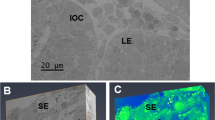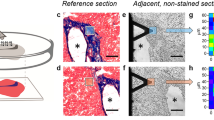Abstract
THE three currently accepted three dimensional models for the structure of the collagen fibril predict alternating regions of high and low density along the length of the fibril, with a repeat length (D) of about 650 Å (Fig. 1a)1–3. As in the previous two dimensional “modified quarterstagger” model4,5, the denser regions (A bands) are about 0.4 D in length, the less dense or “hole” regions (B bands) are about 0.6 D, and the tropocollagen molecular length is 4.4 D. The electron micrographs of negatively stained native and reconstituted collagen, on which the models are largely based, vividly display large banded features which have been interpreted as due to the higher permeability of the B bands to the dense metal stain6,7. Although electron micrographs of unstained collagen fibrils could be expected to reflect the intrinsic longitudinal density distribution, very few studies have included such micrographs, and these were not detailed8,9. Consequently, we have re-examined unstained collagen fibrils by a simple technique. The observed density patterns seem to conflict with the above models and with the prevailing interpretation of negative staining in collagen.
This is a preview of subscription content, access via your institution
Access options
Subscribe to this journal
Receive 51 print issues and online access
$199.00 per year
only $3.90 per issue
Buy this article
- Purchase on Springer Link
- Instant access to full article PDF
Prices may be subject to local taxes which are calculated during checkout
Similar content being viewed by others
References
Grant, R. A., Horne, R. W., and Cox, R. W., Nature, 207, 822 (1965).
Veis, A., Anesey, J., and Mussell, S., Nature, 215, 931 (1967).
Smith, J. W., Nature, 219, 157 (1968).
Hodge, A. J., and Petruska, J. A., in Aspects of Protein Structure (edit. by Ramachandran, G. N.), 289 (Academic Press, London, 1963).
Olsen, B. R., Z. Zellforsch., 59, 199 (1963).
Troumans, W. J., Horne, R. W., Gresham, G. A., and Bailey, A. J., Z. Zellforsch., 58, 798 (1963).
Cox, R. W., and Grant, R. A., Clin. Orthop. Rel. Res., 67, 172 (1969).
Schmitt, F. O., Hall, C. E., and Jakus, M. A., J. Cell. Comp. Physiol., 20, 11 (1942).
Hofmann, U., Nemetschek, T., and Grassman, W., Z. Naturforsch., 7b, 509 (1952).
Cox, R. W., Grant, R. A., and Horne, R. W., J. Roy. Microsc. Soc., 87, 123 (1967).
Burge, R. E., and Silvester, N. R., J. Biophys. Biochem. Cytol., 8, 1 (1960).
Author information
Authors and Affiliations
Rights and permissions
About this article
Cite this article
SPADARO, J. Structural Implications of Banding in Unstained Collagen. Nature 228, 78–79 (1970). https://doi.org/10.1038/228078a0
Received:
Issue Date:
DOI: https://doi.org/10.1038/228078a0
Comments
By submitting a comment you agree to abide by our Terms and Community Guidelines. If you find something abusive or that does not comply with our terms or guidelines please flag it as inappropriate.



